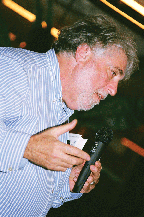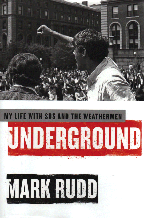By MORDECAI SPECKTOR
Mark Rudd was the face of campus protest against the Vietnam War. As the leader of Students for a Democratic Society (SDS) at New York’s Columbia University, he rallied his fellow students to occupy campus buildings in the spring of 1968, and shut down the institution that the radical activists found to be implicated in the war and societal racism.
He was pictured on the cover of Newsweek magazine, scuffling with a campus security guard; the cartoon strip “Doonesbury” featured a character called “Megaphone Mark” inspired by Rudd’s antics.
In a fascinating new memoir, Underground: My Life with SDS and the Weathermen (William Morrow), the Jewish rebel from the New Jersey suburb of Maplewood, recounts his role in leading the largest student antiwar group in the country, and later helping to dismantle the organization, as he and a small group of like-minded revolutionists — disproportionately Jews — formed the Weatherman faction.
Operating underground in America, the leftist cult punctuated their declared war on the U.S. government with the detonation of bombs in government buildings and corporate headquarters.
It is a wild story and Rudd, who now has profound regrets about the excesses and tragic miscalculations of that turbulent chapter in our history, offers an honest and often raw account in Underground. He recently spoke at length about his memoir, and his matured outlook on politics and life, with the American Jewish World, in a telephone interview from his home in Albuquerque, N.M.

Asked about the disproportionate number of Jews in SDS and the Weather Underground, as Rudd’s faction was known, the 62-year-old activist mentioned that he focused on that topic in a 2005 talk to the New Mexico Jewish Historical society.
In his lecture, “Why Were There So Many Jews in SDS? (Or, The Ordeal of Civility),” Rudd says that “the numbers on Jews in SDS are clear. The author Paul Berman, himself a Jewish veteran of Columbia SDS, in his excellent book, A Tale of Two Utopias, gives the following data from reliable sources: two-thirds of the white Freedom Riders who traveled to Mississippi were Jewish; a majority of the steering committee of the 1964 Berkeley Free Speech Movement were Jewish; the SDS chapters at Columbia and the University of Michigan were more than half Jewish; at Kent State in Ohio, where only five percent of the student body was Jewish, Jews constituted 19 percent of the chapter. I might add a strange statistic which I became aware of in the course of two trips to Kent State to commemorate the events of May, 1970: three of the four students shot by the National Guard at Kent State were Jewish. This, of course, defies all odds.”
On brief reflection, however, Rudd can’t recall much in the Jewish teachings from his youth that specifically inspired him to act in solidarity with the struggling Vietnamese or the blacks languishing in urban ghettoes.
“The congregation which I grew up in did not have any social gospel, you might say,” says Rudd, regarding his formative years in New Jersey. “The context is very important: we were refugees, from Newark to the suburbs. One might have thought that the plight of black people, the civil rights movement, would have been an important topic, but it wasn’t. The sort of informal topic was, watch out for the schwartzes [Yiddish pejorative for “blacks”]. That’s why we came to the suburbs. It’s a straight Philip Roth environment that I grew up in.” Rudd mentions that he was born in Newark, “just a few blocks from the neighborhood” that the renowned Jewish novelist writes about.
Local historians have written in recent years about Jewish migrations in the Twin Cities — from the Minneapolis North Side to St. Louis Park, and from St. Paul’s West Side to Highland Park; Roth similarly traces the flight of New Jersey’s Jews in his fiction, according to Rudd.
“[Roth’s 1959 story] Goodbye, Columbus is about the exodus of the Jews, from Newark,” comments Rudd; the story’s main character is a “working class Jew who falls in love with an upper middle class Jew from Short Hills.”
Indeed, Roth went on to write about Jewish radicalism in his 1997 novel American Pastoral, which focuses on an upstanding suburban Jewish family’s rebellious daughter, who plants a bomb in the local post office and inadvertently kills an elderly doctor.
The protagonist in American Pastoral, Seymour “Swede” Levov is consumed by the fate of his missing daughter, Merry, who has committed a heinous crime and then vanished into the radical political netherworld. Like Rudd’s late parents, who were anguished during his days underground — seven years in flight from the FBI — Levov obsessively scans the newspapers for the names of those “who were wanted by the authorities for crimes allegedly stemming from antiwar activities, girls that he imagined Merry knew, girls with whose lives he imagined his daughter’s to be now interlinked… [Levov’s] father, after foolishly watching a TV news special about the police hunt for the underground Weathermen, among them Mark Rudd and Katherine Boudin and Jane Alpert — all in their twenties, Jewish, middle class, college-educated, violent in behalf of the antiwar cause, committed to revolutionary change and determined to overturn the United States government — went around saying, ‘I remember when Jewish kids were home doing their homework. What happened? What the hell happened to our smart Jewish kids?’”
Underground provides an inside look at the student-led takeover of buildings on the Columbia campus in 1968. The SDS activists invaded the office of President Grayson Kirk, rifling through his files, tasting his sherry and smoking his cigars.
Rudd writes: “I wandered over to Kirk’s magnificent mahogany desk, sank down exhausted in his executive armchair, and idly picked up the phone. The dial tone was still working and, without thinking, I called home. My father answered, still drowsy from sleep.
“‘We took a building,’ I said. ‘Well, give it back,’ he replied from our ranch house in Maplewood, fourteen miles outside New York City.”
Rudd adds that his mother then gets on the extension and tells him that, after watching the TV news about the turmoil on the Columbia campus, they have been “worried sick” that he would “get hurt or arrested.”
In an article last month in the New Jersey Jewish News about the publication of Underground, staff writer Robert Wiener recalls a talk Rudd gave at the West Orange JCC in April 2003.
“That night the key issue was not why he took part in advocating armed struggle to overthrow the United States government, or how he felt about the Palestinian-Israeli conflict,” Wiener writes. “In fact, the most profound questioning came from his elderly mother, the late Bertha Rudd, who died on June 18. ‘How could you do this to me?’ she asked, and the audience roared with laughter.”
The now-bearded and portly former student radical deals frankly in the memoir with the tsuris he caused his parents, who were both supportive — they gave him substantial sums of money when he was on the lam — and fearful for their son throughout his underground days. (Rudd’s father, Jake, a successful businessman and army officer, passed away in 1995.)
Again, on the topic of Judaism and social justice, Rudd responds, “I don’t think I got the social ethics of Judaism, as part of the theology. On the other hand, you mentioned the tradition of Jews as liberals, as progressives — yes. I didn’t necessarily get that from my family; but when I got to Columbia, I met a lot of red diaper babies, and many of them were Jewish, and that affected me very deeply.”
Thinking about his New Mexico talk (which can be found on his Web site: markrudd.com), Rudd says his theory is that “being Jewish gave me was a critical view of the society, as an outsider. I was definitely raised in the immigrant family mentality; it was always us versus them, the real Americans versus the Jews.”
A turning point in Rudd’s thinking came after three of his comrades were killed when they accidentally detonated a bomb they were making. The explosion, on March 6, 1970, killed Terry Robbins, Ted Gold and Diana Oughton, and leveled a four-story Greenwich Village townhouse. Rudd was among the Weathermen who had approved of the proposed bombing of a dance for noncommissioned officers and their dates at Fort Dix in New Jersey. The terrorists-in-training were assembling anti-personnel bombs made of dynamite and roofing nails, when they accidentally completed an electrical circuit in the bomb’s triggering device.
This seminal event was examined in the 2003 documentary The Weather Underground, by Sam Green and Bill Siegel (who is from Minneapolis). The Academy Award-nominated film features Rudd’s reflections on the mistakes he and his comrades made in the late ’60s and early ’70s; Rudd says in the film that he felt “guilt and shame” for some of his actions.
“I did that interview in 1999 — actually, it was 10 years ago, this summer,” Rudd recalls. “I think in writing the book I’ve come to terms with the mistakes, the dreadful mistakes that we made; and the greatest of all was the strategy of armed struggle, urban guerrilla warfare. I mean, that was crazy, it was totally counter-productive.”
Rudd adds that he regrets specific egregious errors, including the Greenwich Village bomb disaster that took the lives of “three really wonderful young people, two of whom [Robbins and Gold] were Jewish.”
He adds that the greatest strategic mistake he helped engineer was “the decision to destroy SDS in the fall of 1969, in order to build the underground.” Rudd characterizes that benighted move as “totally undemocratic. I write in the introduction to my book that it was playing into the hands of the FBI.”
Underground is hard to put down once Rudd’s narrative begins picking up steam. Many AJW readers will recall the heady mood of the times; for younger readers, the descriptions of the culture clash, bitter race relations, and a core of zealots crazed by their government’s waging of a genocidal war in Southeast Asia will come as a revelation. When Rudd and his colleagues finally came up from underground, most of the criminal charges against them had been dismissed, because the government had engaged in rampant illegal searches and dirty tricks and poisoned the legal cases against the radicals.
It should be mentioned that Rudd, who has remained engaged in various progressive political causes over the past 30 years, now advocates for disciplined nonviolent tactics in pursuance of social change.
“The violence of the era — in Vietnam and on the streets of this country — and the tragic consequences have to be looked at clearly and rationally,” Rudd writes in the epilogue toUnderground. We need a truth and reconciliation process, such as happened in South Africa, to finally put an end to the suffering.”
(American Jewish World, Aug. 7, 2009)





















If I remember correctly, the founder of National SDS, Tom Hayden, was Irish-American and the most prominent leader of the 1964 Berkeley Student Revolt, Mario Savio, was Italian-American. And in 1968, Student Afro-American Society (SAS) leaders like Bill Sales and Ray Brown probably may have played a more decisive leading role politically than Mark in the New Left’s shut-down of Columbia University. For more info about the role of African-American students at Columbia in 1968, readers might want to check out Professor Stefan Bradley’s new book, “Harlem vs. Columbia University.”